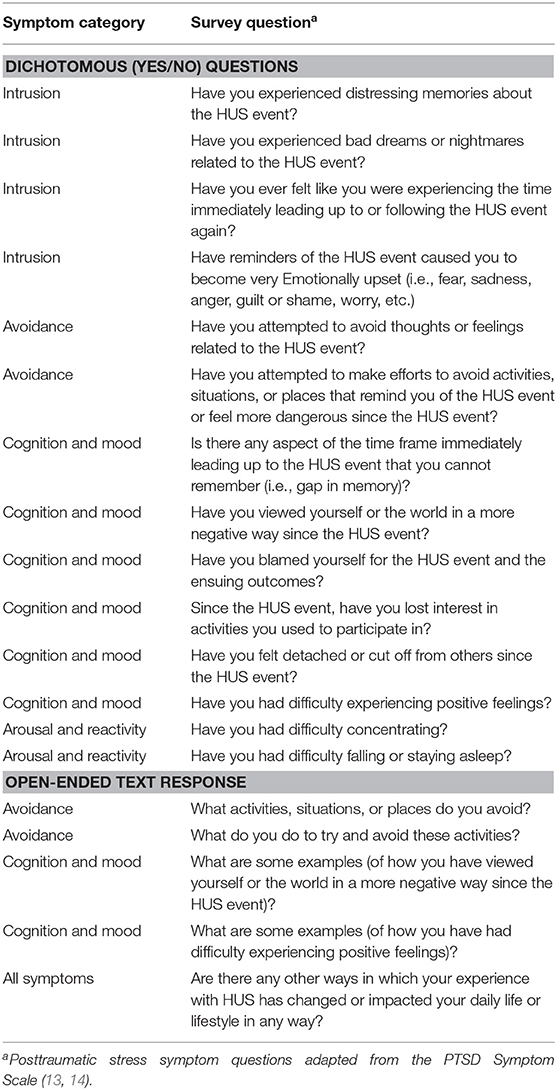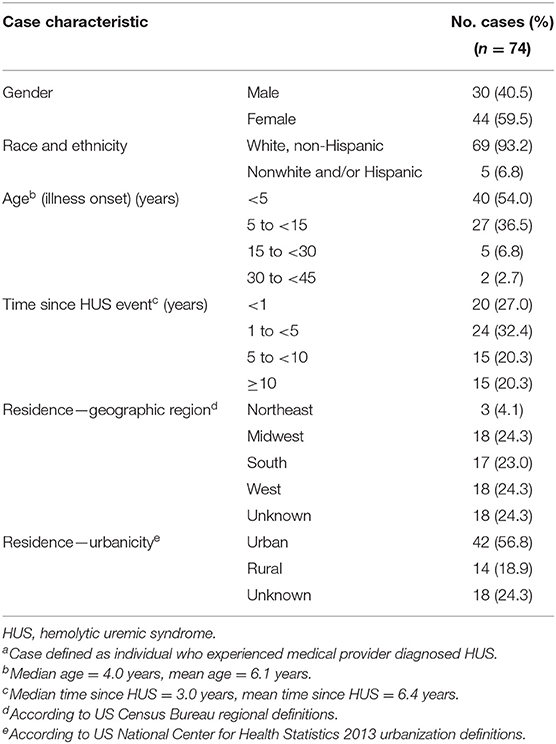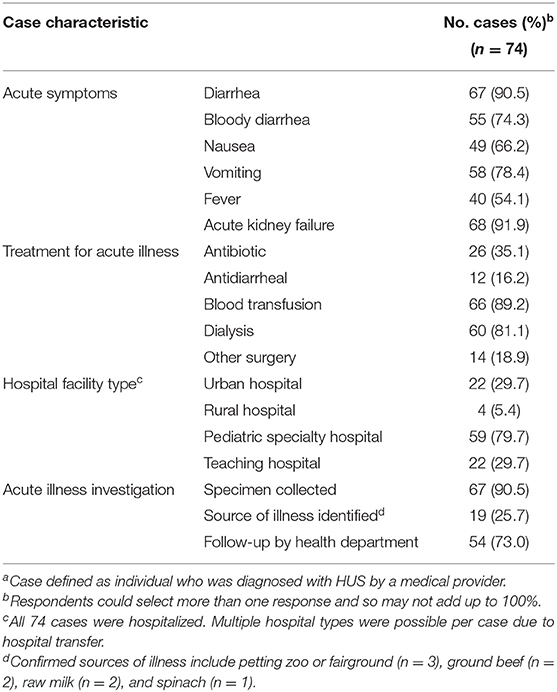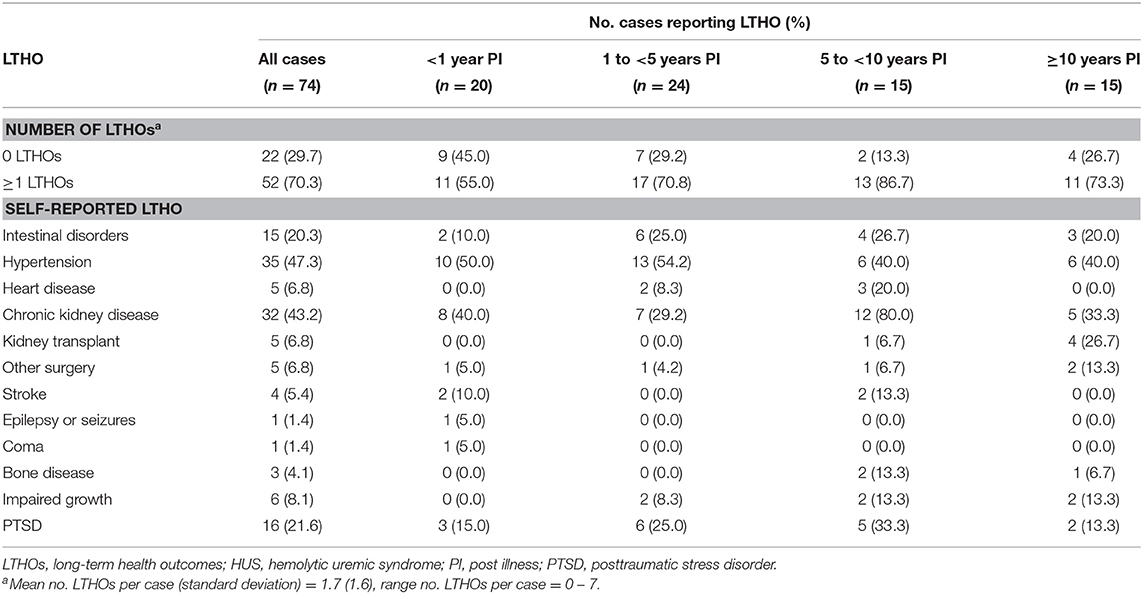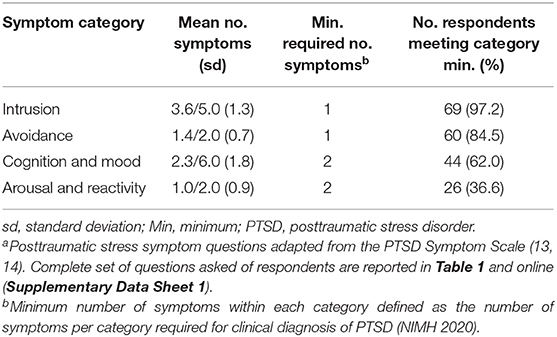- 1Department of Food Science and Technology, The Ohio State University, Columbus, OH, United States
- 2Department of Human Sciences, The Ohio State University, Columbus, OH, United States
Individual burden and cost of hemolytic uremic syndrome (HUS)—a medical condition characterized by acute kidney failure—can be substantial when accounting for long-term health outcomes (LTHOs). Because of the low incidence of HUS, evaluation of associated LTHOs is often restricted to physician and outbreak cohorts, both of which may not be representative of all HUS cases. This exploratory study recruited participants from private social media support groups for families of HUS cases to identify potential LTHOs and costs of HUS that are not currently measured. Additionally, this study sought to identify case characteristics that may confound or modify these LTHOs and costs of HUS. Respondents self-selected to complete an online cross-sectional survey on acute and chronic illness history, treatments, and public health follow-up for HUS cases. Posttraumatic stress among respondents (typically case parents) was also evaluated. Responses were received for 74 HUS cases from 71 families representing all geographic regions, and levels of urbanicity within the US self-reported symptoms were typical for HUS, while 35.1% of cases reported antibiotic treatment at any point during the acute illness. Hospital transfers were reported by 71.6% of cases introducing possible delays to care. More than 70% of cases reported experiencing at least one LTHO, with 45% of cases reporting renal sequelae. Posttraumatic stress symptoms were frequently reported by respondents indirectly affected by HUS. Potentially large economic costs that are not addressed in existing analyses were identified including both financial and more general welfare losses (lost utility). While biases in the study design limit the generalizability of results to all HUS cases, this study provides new insights into unmeasured LTHOs and costs associated with HUS. These results suggest that robustly designed cohort studies on HUS should include measures of psychosocial impacts on both the affected individual and their family members.
Introduction
Hemolytic uremic syndrome (HUS) is a medical condition characterized by acute kidney failure resulting from hemolytic anemia and thrombocytopenia (1–3). HUS is commonly associated with Shiga toxin–producing Escherichia coli (STEC) infections, and 4–17% of STEC O157:H7 illnesses are estimated to progress to HUS (4). The incidence of HUS in the United States is relatively low with the Foodborne Diseases Active Surveillance Network (FoodNet) identifying 54 cases (0.49 cases per 100,000 persons) of pediatric HUS in 2017 (5). Despite the low incidence, the individual burden of HUS can be quite substantial. For example, HUS has an approximate 5% mortality rate, and renal and circulatory system sequelae are estimated to occur among 25% of HUS survivors (6, 7). The economic burden of HUS is estimated to be $541,695 per case (8), but many of the long-term health outcomes (LTHOs) associated with HUS (9, 10) have not been included in these estimates because of insufficient evidence. Thus, the individual burden of HUS may be substantially higher.
The potential for underestimating the burden of HUS is further heightened when considering potential LTHOs that are not currently identified or measured among cases. For example, there has been relatively little attention paid to potential psychosocial impacts of HUS on both the patient and their families. Given that HUS primarily affects young children, the 2017 incidence of HUS among children <5 years old (1.22 cases per 100,000 persons) was more than double that for all pediatric cases as previously cited—there are potentially substantial psychosocial ramifications for family members who are responsible for providing care to HUS survivors (5, 11). For example, a previous study of 30 HUS case–parent dyads in Scotland identified emotional and psychological distress, changes to daily behavior, and increased fear of the future among interviewed parents (12). Recognizing the limitations of the qualitative methods they used, Pollock et al. recommended measuring the psychosocial impact of HUS among families through diagnosis of posttraumatic stress disorder (PTSD) or another defined metric.
Identifying and evaluating the scope of LTHOs among HUS cases have been difficult, largely due to the low incidence. Consequently, studies on sequelae associated with HUS have been primarily restricted to physician cohorts, which are potentially biased toward higher severity cases needing more specialized care; cohorts established following large outbreaks, which may not be representative of sporadic HUS cases; and systematic reviews or meta-analyses of physician and outbreak cohorts (4). While a cohort study design is preferred for estimating prevalence and relative risk of LTHOs following acute illness, such studies are often resource-intensive and have small sample sizes, discouraging inclusion of additional exploratory data collection. In contrast, exploratory cross-sectional surveys of social media support communities offer a low-cost approach for discovering factors that should be further examined in cohort studies. Therefore, a cross-sectional survey of members of two HUS-related social media groups was undertaken to identify potential LTHOs and costs of HUS that are not currently measured. Additionally, this study sought to identify case characteristics that may confound or modify these LTHOs and costs of HUS as risk factors can be important in studies that extrapolate from samples to populations as a means of adjusting outcomes for population characteristics.
Materials and Methods
This cross-sectional study recruited participants from two private Facebook support groups for families of individuals who developed HUS following an infectious diarrheal illness. No minimum a priori sample size was determined, and respondents (primarily HUS case parents) self-selected over a span of 1 month (February 2019) to complete an online survey developed and distributed by the research team using Qualtrics Online Survey Software (Provo, UT) (Supplementary Data Sheet 1). Because of the exploratory nature of this study and the limited pool of potential participants, the survey instrument was not validated prior to distribution. Within the survey, respondents were asked a series of questions on the acute illness, public health follow-up, chronic illnesses, treatments for HUS, and related sequelae experienced by the HUS case. Additionally, survey respondents were asked about posttraumatic stress (PTS) symptoms related to the HUS event. LTHOs were included within the survey if they have been previously reported in the literature as potential sequelae of foodborne infectious diseases including HUS, salmonellosis, campylobacteriosis, and yersiniosis among others (9). These LTHOs included intestinal disorders, hypertension, heart disease, chronic kidney disease, kidney transplant, surgery other than organ transplant, stroke, epilepsy or seizures, coma, bone disease (e.g., osteomyelitis) or skeletal deformities, impaired growth, and self-reported PTSD. Death following HUS was not included among outcomes evaluated to minimize risk of emotional stress on study participants while completing the survey. Questions evaluating PTS symptoms were adapted from a tool previously developed to assess PTSD symptoms aligning with the Diagnostic and Statistical Manual of Mental Disorders (5th edition) (Table 1) (13, 14). Respondents were classified as having PTS if they reported the minimum number of symptoms (one intrusion symptom, one avoidance symptom, two cognition and mood symptoms, and two arousal and reactivity symptoms) in all categories as required for clinical diagnosis of PTSD (NIMH 2020).
Responses were classified and analyzed as a case if they reported that HUS was officially diagnosed by a medical provider. Sociodemographic factors, acute symptoms, clinical care, and LTHOs experienced by the HUS case and PTS experienced by respondents were summarized with descriptive statistics. Geographic location at time of illness was categorized according to US Census Bureau regional definitions. Urbanicity of residence at time of illness was categorized according to the National Center for Health Statistics 2013 urbanization definitions by zip code.
Logistic regression was used to explore whether report of any LTHO was higher as time (categorized as <1, 1 to <5, 5 to <10, ≥10 years) progressed since a case's HUS illness. Logistic regression was also used to explore potential risk factors for specific LTHOs among HUS cases and for PTS among respondents. Considered risk factors were case demographics, acute illness symptoms, treatment, and hospitalization history. All potential risk factors were included in the multivariable model selection process, which utilized a backward selection approach to estimate odds ratios adjusted (at minimum) for case age and gender. Qualitative analysis of open text response questions pertaining to PTS among respondents was performed, and recurring themes identified across respondents. Statistical analyses were performed using SAS 9.4 (Cary, NC). Appropriate ethical approvals were obtained from The Ohio State University Social and Behavioral Institutional Review Board (study #2018B0456).
Results
Acute Illness
Surveys were completed for 84 illness events. Ten surveys were excluded from analyses because of no report of official HUS diagnosis by a medical provider resulting in a final study population of 74 HUS cases from among 71 families. The mean and median time elapsed between the HUS event and survey completion was 6.4 and 3.0 years, respectively (Table 2). All geographic regions and levels of urbanicity within the US were represented among the case population. More than 50% of cases developed HUS when they were younger than 5 years. Self-reported acute illness symptoms were typical for STEC and HUS, with a majority of individuals reporting bloody diarrhea and acute kidney failure (Table 3). A source of illness (e.g., contaminated food item) was identified for 19 (25.7%) of the 74 HUS cases. Interestingly, there was an increasing trend in antibiotic use with 35% of HUS cases reporting treatment with antibiotics at any point during the acute phase of illness (Figure 1).
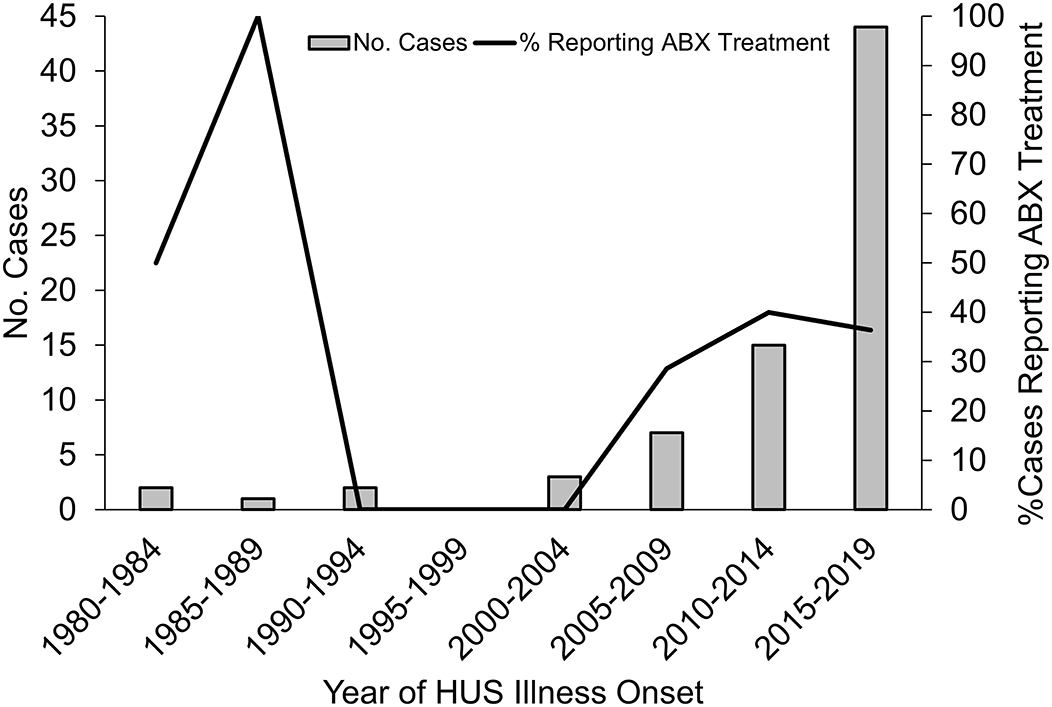
Figure 1. Self-reported antibiotic treatment among HUS cases by year of illness onset. HUS, hemolytic uremic syndrome; ABX, antibiotic; STEC, Shiga toxin–producing E. coli. Report of antibiotic treatment refers to treatment at any point during the acute illness phase and does not distinguish between treatment before and/or after diagnosis with STEC or HUS.
Cases were predominantly treated at pediatric specialty hospitals, with 53 cases (71.6%) being transferred to a different hospital during their acute illness. Self-reported reasons for hospital transfer (with some cases reporting multiple reasons) included need for pediatric specialist by 26 transferred cases (49.1%), need for renal specialist by 15 transferred cases (28.3%), need for dialysis unavailable at initial facility for 12 transferred cases (23.6%), rural or small hospital unable to provide necessary care for six transferred cases (11.3%), and medical provider at initial location unsure of diagnosis and/or treatment for HUS for four transferred cases (7.5%).
Long-Term Health Outcomes
At least one LTHO was reported by 52 cases (70.3%), with renal sequelae (hypertension and chronic kidney disease) being the most commonly reported (Table 4). Length of time between HUS event and survey completion (<1, 1 to <5, 5 to <10, ≥10 years) was not significantly associated with report of any LTHO. The small number of cases in the 5+ years postillness groups hindered the evaluation of potential associations between time since illness and LTHOs. Univariable analyses identified associations between acute illness factors and chronic kidney failure, surgery other than transplant, bone disease (e.g., osteomyelitis), and self-reported PTSD (Table 5). Complete univariable analyses for LTHO risk factors are available online (Supplementary Table 1). The multivariable model for chronic kidney failure identified associations with urbanicity, acute dialysis, and hospital transfer (adjusting for case age and gender); the multivariable model for self-reported PTSD identified associations with case age and hospital transfer (adjusting for case gender) (Table 6). There were no significant factors for surgery other than transplant and bone disease in the multivariable model.

Table 5. Significant univariable logistic regression associations between risk factors and long-term health outcomes following HUSa.
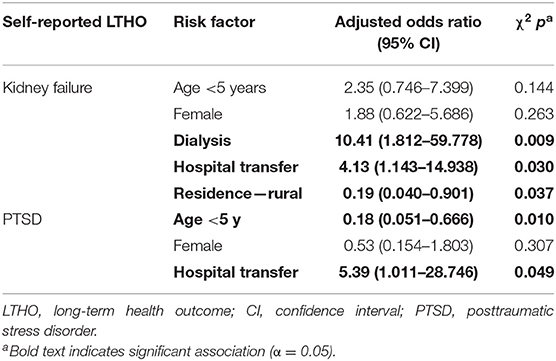
Table 6. Multivariable logistic regression associations between risk factors and long-term health outcomes following HUS.
Posttraumatic Stress and Costs of Illness
Stress symptoms were reported by 69 survey respondents (97.2%) (Table 7). Twenty respondents (28.2%) reported the minimum number of symptoms across all categories and met this study's definition of PTS. Among potential risk factors evaluated, only case age younger than 5 years was marginally associated (α = 0.10) with PTS among survey respondents (Table 8). Controlling for other case acute factors such as gender, race, and ethnicity and urbanicity did not significantly improve the model fit for PTS and case age.
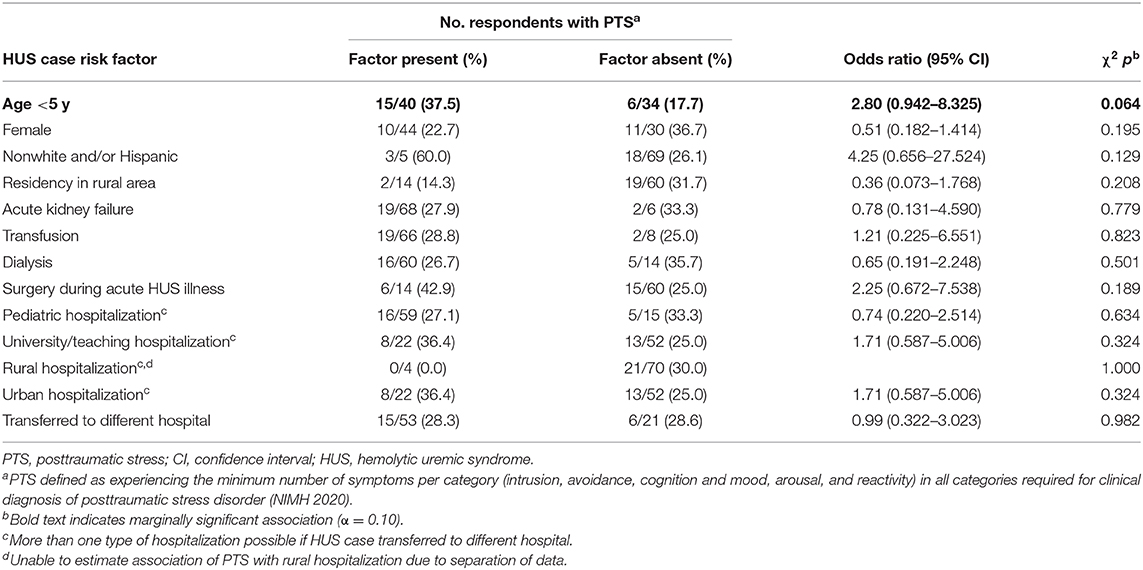
Table 8. Univariable logistic regression associations between acute risk factors and posttraumatic stress among respondents following an HUS event.
Situations, places, and activities avoided by respondents following the HUS event included outdoor activities (e.g., camping, swimming), agritourism (e.g., petting zoos, farms, fairs, and festivals), foods and/or locations associated with contracting the illness, and medical facilities frequented for clinical care during and after the HUS illness. Ways in which respondents viewed themselves or the world more negatively since the HUS event were synthesized into recurring themes of (1) distrust of others (e.g., agriculture and food industries, government agencies, and medical professionals), (2) fear and anxiety for future medical needs of HUS survivors, and (3) blaming oneself for a dependent child becoming ill. Selected open-ended responses demonstrating potential costs of HUS include the following:
• adjusting work (healthcare setting) responsibilities to avoid eliciting memories of HUS event
• discontinuation of work to provide long-term care for HUS survivor
• parental use of medical leave for depression following an HUS event
• postponing medical care unrelated to HUS due to fear and avoidance of healthcare facilities
• disruption of childhood education of HUS survivor due to LTHO management.
Discussion
This work demonstrates that social media–based support communities can serve as a low-cost means of identifying potential burdens that have previously been overlooked in cohort studies of HUS and other low-incidence infectious diseases. While previous studies have quantified the economic burden from HUS based on direct medical expenses, productivity losses, and deaths (8, 15), this study has identified potentially large economic costs that are not currently addressed in cohort studies of HUS and existing burden analyses. These unmeasured economic costs include both financial and more general welfare losses (lost utility). Missing financial costs include travel costs associated with hospital transfers, a better accounting of caregiver costs from lost productivity, and some medical costs associated with resulting LTHOs. Perhaps more importantly, assessments of lost welfare from psychosocial impacts associated with HUS are notably absent in the literature. Specifically, HUS-related costs have not been estimated for mental health services, productivity losses due to PTS induced presenteeism and absenteeism, and other avoidance effects. A high probability (28.2%) of PTS in this admittedly self-selected sample suggests that these costs could be very high. The financial cost per patient for major depressive disorder, for example, has been estimated to be $5,988 annually (16). Additionally, there are substantial utility losses for those affected by HUS. Both patients and family members suffer from these losses during treatment and, in many cases, long afterward. Having a better understanding of the total economic burden associated with HUS is important, both as a means of understanding how to provide sufficient care for families affected by the illness and as a means of directing scarce public health resources toward a problem that has, to this point, been undervalued.
This work also demonstrates the utility of social media–based support groups for identifying research priorities that warrant additional consideration. For example, it was surprising that 35% of cases in this study were treated with antibiotics during their acute illness (Figure 1). Despite conflicting evidence on associations between antibiotic treatment of STEC infections and risk of developing HUS (17), the US Centers for Disease Control and Prevention (CDC) recommends against use of antibiotics in the treatment of STEC infections (CDC 2019). This study was not able to determine whether antibiotics were prescribed empirically before or after diagnosis of either STEC or HUS. It is also important to note that these results should be interpreted with caution as the cross-sectional design and use of self-reported treatments may introduce recall bias. Still, it can be inferred that the cases identified by this study are likely to be representative of typical HUS cases in the United States given that self-reported symptoms and LTHOs aligned with those commonly reported by HUS cases (1–3). Additionally, the study was able to recruit a participant population similar in demographic profile to that of pediatric HUS cases ascertained by the FoodNet active surveillance system from 2000 to 2010 (18), and cases were enrolled from all geographic regions and levels of urbanicity within the United States. This suggests that, while this study was not designed for robust estimation, unmeasured outcomes or surprising results identified by this study are likely present, to some degree, within the population and require further consideration in studies capable of quantifying risk. Consequently, further exploration of this specific phenomenon is warranted to understand whether these results are indicative of broader prescribing practices.
Through exploratory risk factor analyses, this study also identified case characteristics that may confound or modify LTHOs and costs of HUS, which would be important for cohort studies seeking to adjust estimates when extrapolating from samples to populations. Specifically, adjusted odds of chronic kidney failure and self-reported PTSD were higher for patients who were transferred to a new facility compared to those who were not. This is not surprising given that hospital transfer may be a surrogate for more severe acute illness and driven by the need for dialysis, which, as seen in this study, has been associated with increased risk of chronic kidney failure among HUS cases (19). For example, 3 years after a German E. coli O104:H4 outbreak associated with sprouts, 32 of 72 (44%) HUS cases had renal sequelae, and dialysis during acute illness was associated with increased risk of renal sequelae (20). Adjusted odds of chronic kidney failure in this study were also lower among urban cases compared to rural cases. Several studies have shown that rural populations have higher exposure to STEC (21, 22) and consequently are at higher risk of HUS (23), although these results are not consistent with other studies (24). While sample size (74 HUS cases from among 71 families) likely limited this study to detecting only large effects, it is notable that the sample size in this study is larger than most cohort studies on LTHOs of HUS which frequently consist of <50 cases (4). Even so, the univariable and multivariable associations reported by this study between risk factors and LTHOs should not be interpreted as true population estimates. Instead, these results should be viewed as justification for inclusion of the associated case characteristics (e.g., residence urbanicity, type of hospital, history of hospital transfer) in future research on LTHOs of HUS due to their potential to confound or modify estimates.
There are several limitations that affect the generalizability of these results. The primary limitation of this study was self-selection bias, which is inherent in using an online survey with self-reported symptoms. Specifically, individuals with more severe LTHOs may have been more likely to either join a social media support group and/or respond to this survey, especially if experiencing PTS symptoms and/or LTHOs. This could lead to overestimation if the results were used to quantify burden directly. Because the objective of this study was to identify unmeasured outcomes, a greater likelihood of identifying extreme outcomes due to self-selection bias becomes a strength. The other key limitation of this work is the potential for recall bias. The majority of HUS cases identified by this study occurred within the 5 years leading up to completing the survey, which would be expected to decrease the impact recall bias. However, there may not be an easily definable relationship between time since HUS event and recall bias since PTS—which is characterized by both avoidance and intrusion symptoms—was identified among a large portion of respondents. If an individual experiences more avoidance symptoms, there could be greater recall bias due to subconscious suppression of memories following the HUS event. In contrast, if an individual experiences more intrusion symptoms, the impact of recall bias could be minimized due to frequent recollection of the HUS event. While the present study was unable to investigate further, future exploration of the impact of recall bias on recollection of an HUS event is warranted, given this divergence in recall would extend beyond retrospective social media–based studies to also impact cohort studies and surveillance activities.
While there are limitations inherent to this cross-sectional study, it is important to note that the limitations faced by this study do not conflict with the overarching goal, which was to identify LTHOs and costs of HUS for closer examination in future cohort studies. These results serve as useful starting point for more robust work estimating psychosocial costs to families of HUS cases. With approximately 30% of respondents experiencing PTS, a robustly designed prospective study that is capable of addressing the limitations discussed above is warranted to quantify prevalence and scope of LTHOs of HUS including PTS for integration in future iterations of burden and cost of illness estimation.
Data Availability Statement
The raw data supporting the conclusions of this article will be made available by the authors, without undue reservation.
Ethics Statement
The studies involving human participants were reviewed and approved by Behavioral and Social Sciences IRB at The Ohio State University. Written informed consent from the participants' legal guardian/next of kin was not required to participate in this study in accordance with the national legislation and the institutional requirements.
Author Contributions
AB and BK conceived of and designed the study. AB coordinated data collection, performed statistical analyses, and wrote the first draft of the manuscript. RS and BK wrote sections of the manuscript and contributed to interpretation of data for the work. All authors contributed to manuscript revision, read and approved the submitted version.
Conflict of Interest
AB and RS report no relationships that might be perceived by the academic community as representing a potential conflict of interest. BK, the study principal investigator, had a child who died from HUS in 2001 and is a member of the relevant private social media groups. BK did not participate in the study and was blinded to participant responses.
Acknowledgments
The authors thank the members of the social media groups who participated in this study.
Supplementary Material
The Supplementary Material for this article can be found online at: https://www.frontiersin.org/articles/10.3389/fpubh.2020.544154/full#supplementary-material
References
1. Thorpe CM. Shiga toxin-producing Escherichia coli infection. Clin Infect Dis. (2004) 38:1298–303. doi: 10.1086/383473
2. Tarr PI, Gordon CA, Chandler WL. Shiga toxin-producing Escherichia coli and haemolytic uraemic syndrome. Lancet. (2005) 365:1073–86. doi: 10.1016/S0140-6736(05)71144-2
3. Siegler RL. The hemolytic uremic syndrome. Pediatr Clin North Am. (1995) 42:1505–29. doi: 10.1016/S0031-3955(16)40096-9
4. Keithlin J, Sargeant J, Thomas MK, Fazil A. Chronic sequelae of E. coli O157: systematic review and meta-analysis of the proportion of E. coli O157 cases that develop chronic sequelae. Foodborne Pathog Dis. (2014) 11:79–95. doi: 10.1089/fpd.2013.1572
5. Tack DM, Marder EP, Griffin PM, Cieslak. Preliminary incidence and trends of infections with pathogens transmitted commonly through food – Foodborne Diseases Active Surveillance Network, 10 U.S. Sites, 2015–2018. MMWR. (2019) 68:5. doi: 10.1111/ajt.15412
6. Gould LH, Demma L, Jones TF, Hurd S, Vugia DJ, Smith K, et al. Hemolytic uremic syndrome and death in persons with Escherichia coli O157:H7 infection, Foodborne Diseases Active Surveillance Network sites, 2000–2006. Clin Infect Dis. (2009) 49:1480–5. doi: 10.1086/644621
7. Garg AX, Suri RS, Barrowman N, Rehman F, Matsell D, Rosas-Arellano MP, et al. Long-term renal prognosis of diarrhea-associated hemolytic uremic syndrome: a systematic review, meta-analysis, and meta-regression. JAMA. (2003) 290:1360–70. doi: 10.1001/jama.290.10.1360
8. Hoffmann S, Maculloch B, Batz M. Economic Burden of Major Foodborne Illnesses Acquired in the United States. U.S. Department of Agriculture: ERS (2015) EIB-140.
9. Batz MB, Henke E, Kowalcyk B. Long-term consequences of foodborne infections. Infect Dis Clin North Am. (2013) 27:599–616. doi: 10.1016/j.idc.2013.05.003
10. Porter CK, Choi D, Cash B, Pimentel M, Murray J, May L. Pathogen-specific risk of chronic gastrointestinal disorders following bacterial causes of foodborne illness. BMC Gastroenterol. (2013) 13:46. doi: 10.1186/1471-230X-13-46
11. Griffin PM, Tauxe RV. The epidemiology of infections caused by Escherichia coli O157:H7, other enterohemorrhagic E. coli, and the associated hemolytic uremic syndrome. Epidemiol Rev. (1991) 13:60–98. doi: 10.1093/oxfordjournals.epirev.a036079
12. Pollock KGJ, Duncan E, Cowden JM. Emotional and behavioral changes in parents of children affected by hemolytic-uremic syndrome associated with verocytotoxin-producing Escherichia coli: a qualitative analysis. Psychosomatics. (2009) 50:263–9. doi: 10.1176/appi.psy.50.3.263
13. Foa EB, Cashman L, Jaycox L, Perry K. The validation of a self-report measure of posttraumatic stress disorder: the posttraumatic diagnostic scale. Psychol Assess. (1997) 9:445–51. doi: 10.1037/1040-3590.9.4.445
14. Foa EB, McLean CP, Zang Y, Zhong J, Rauch S, Porter K, et al. Psychometric properties of the posttraumatic stress disorder symptom scale interview for DSM−5 (PSSI−5). Psychol Assess. (2016) 28:1159. doi: 10.1037/pas0000259
15. Scharff RL. The economic burden of foodborne illness in the United States. In: Roberts T, ed. Food Safety Economics: Incentives for a Safer Food Supply. New York, NY: Springer International Publishing (2018). p. 123–142.
16. Greenberg PE, Fournier A-A, Sisitsky T, Pike CT, Kessler RC. The economic burden of adults with major depressive disorder in the United States (2005 and 2010). J Clin Psychiatry. (2015) 76:155–62. doi: 10.4088/JCP.14m09298
17. Freedman SB, Xie J, Neufeld MS, Hamilton WL, Hartling L, Tarr PI, et al. Shiga toxin–producing Escherichia coli infection, antibiotics, and risk of developing hemolytic uremic syndrome: a meta-analysis. Clin Infect Dis. (2016) 62:1251–8. doi: 10.1093/cid/ciw099
18. Mody RK, Luna-Gierke RE, Jones TF, Comstock N, Hurd S, Scheftel J, et al. Infections in pediatric postdiarrheal hemolytic uremic syndrome: factors associated with identifying Shiga toxin–producing Escherichia coli. Arch Pediatr Adolesc Med. (2012) 166:902–9. doi: 10.1001/archpediatrics.2012.471
19. VanSickle JS, Srivastava T, Alon US. Risk factors for short- and long-term outcomes in children with STEC-HUS/D+ HUS: a single-center experience. Glob Pediatr Health. (2018) 5:1–7. doi: 10.1177/2333794X18816920
20. Loos S, Aulbert W, Hoppe B, Ahlenstiel-Grunow T, Kranz B, Wahl C, et al. Intermediate follow-up of pediatric patients with hemolytic uremic syndrome during the 2011 outbreak caused by E. coli O104:H4. Clin Infect Dis. (2017) 64:1637–43. doi: 10.1093/cid/cix218
21. Griffin PM, Karmali MA. Emerging public health challenges of Shiga toxin–producing Escherichia coli related to changes in the pathogen, the population, and the environment. Clin Infect Dis. (2017) 64:371–6. doi: 10.1093/cid/ciw708
22. Haack JP, Jelacic S, Besser TE, Weinberger E, Kirk DJ, McKee GL, et al. Escherichia coli O157 exposure in Wyoming and Seattle: serologic evidence of rural risk. Emerg Infect Dis. (2003) 9:1227–31. doi: 10.3201/eid0910.020254
23. van de Kar NC, Roelofs HGR, Muytjens HL, Tolboom JJ, Roth B, Proesmans W, et al. Verocytotoxin-producing Escherichia coli infection in hemolytic uremic syndrome in part of Western Europe. Eur J Pediatr. (1996) 155:592–5. doi: 10.1007/s004310050448
Keywords: hemolytic uremic syndrome, long-term health outcomes, posttraumatic stress (PTS), foodborne illness, burden of illness, cost of illness (COI)
Citation: Beczkiewicz ATE, Scharff RL and Kowalcyk BB (2020) Facilitating Evaluation of Hemolytic Uremic Syndrome Long-Term Health Outcomes Through Social Media Support Groups. Front. Public Health 8:544154. doi: 10.3389/fpubh.2020.544154
Received: 19 March 2020; Accepted: 22 October 2020;
Published: 23 November 2020.
Edited by:
Alberto Eugenio Tozzi, Bambino Gesù Children Hospital (IRCCS), ItalyReviewed by:
Francois Provot, Centre Hospitalier Regional et Universitaire de Lille, FranceKristen Pogreba-Brown, University of Arizona, United States
Copyright © 2020 Beczkiewicz, Scharff and Kowalcyk. This is an open-access article distributed under the terms of the Creative Commons Attribution License (CC BY). The use, distribution or reproduction in other forums is permitted, provided the original author(s) and the copyright owner(s) are credited and that the original publication in this journal is cited, in accordance with accepted academic practice. No use, distribution or reproduction is permitted which does not comply with these terms.
*Correspondence: Barbara B. Kowalcyk, a293YWxjeWsuMUBvc3UuZWR1
 Aaron T. E. Beczkiewicz
Aaron T. E. Beczkiewicz Robert L. Scharff2
Robert L. Scharff2 Barbara B. Kowalcyk
Barbara B. Kowalcyk